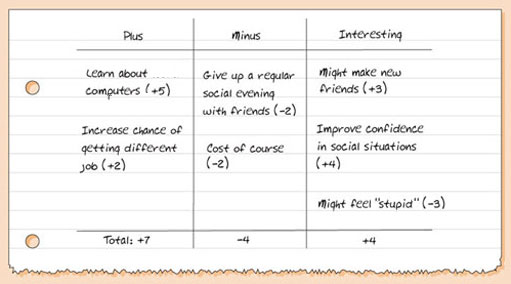4 Turning visions into goals
If you are going to design a realistic and practical plan for yourself, the first thing to do is to select just one long-term goal as the focus of your planning.
You may find this straightforward. If you have a look at your notes on your vision, and at your mind map about your ideal future, you may be able to identify one long-term goal (at least one year away) that you would really like to start working towards achieving. If so, write this in your learning or action planning journal. If you struggle to choose between a couple of goals, then the following technique may be particularly helpful.
There is a decision-making technique called PMI which should be useful either to test the one goal you have selected or to help you to decide between one or two in a shortlist.
PMI stands for plus, minus and interesting. This is how it works. For each possible goal, do the following:
- Create a table with three columns – ‘Plus’, ‘Minus’ and ‘Interesting’ – similar to Figure 4.
- In the ‘Plus’ column, write all the advantages for choosing this goal.
- In the ‘Minus’ column, write all the disadvantages.
- The ‘Interesting’ column is for thoughts that don’t quite fit either of the others, but are possible outcomes of making the decision.
- Now put a rating score by each between 1 and 5, depending on how strongly you feel about them. Those in the ‘Plus’ column should have a plus sign. Those in the ‘Minus’ – guess what – have a minus sign. For the ones in the ‘Interesting’ column, you need to decide whether you see them as positive or negative factors.
- There isn’t any really complicated maths here, but you do need to total your scores. If maths isn’t your strong point, it’s probably easiest to add up all your pluses first and then take each of your minuses off in turn. (In this example, it comes to 14 – 7 = 7.) Or you can work out each column as shown below.
- If your final score is positive, it is fair to say that your goal looks promising. If it’s negative, maybe choose a different one. The higher the score, the more promising it is likely to be.
Activity 2 Using PMI
Draw up a PMI chart for the goal you want to test, and put as many comments in each column as you can. Work out your total score. A positive final score should encourage you to take action; a negative score might make you want to think again.
Discussion
It may feel strange putting numbers to decisions such as these, but it can also make you start thinking more objectively about decisions you have to make.
If you are choosing between several goals, repeat this activity for each and then choose the one with the highest score.

